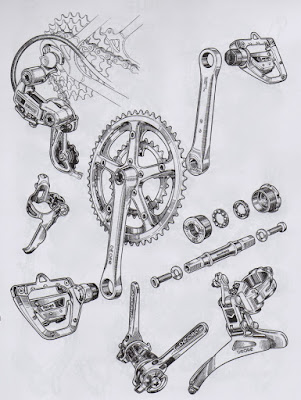The bike/pedestrian lane on the Queens spur of the RFK Memorial (a.k.a. Triborough) Bridge has been closed for "painting and repairs." The signs said the lane would be closed from 9 am to 5 pm from the 1st to the 26th of this month. I didn't figure that it would affect me much, if at all, since I always go in to work before 9 and usually am heading home after 5.
Last Tuesday, however, I didn't leave work until 8 pm. I pedaled across the Randall's Island connector and the island to the Queens spur of the bridge. There, the gate was still locked, with the same sign announcing its closure.
All right, I told myself. Maybe they just forgot to reopen it. That night, it meant backtracking to the north end of the island and the Manhattan spur of the bridge. Then I rode down Second Avenue from 125th Street to the Queensborough (a.k.a. 59th Street) Bridge. It was a longer commute home, but I didn't mind, really.
Well, the Queens spur of the RFK hasn't been opened since. No one from the Department of Transportation has returned my calls. (Should I be surprised?) So, I've been taking another route to and from work. To get to the Bronx, I've been crossing the Queensborough to First Avenue, which has a bike lane all the way up to 125th Street. From there, I take the Willis Avenue Bridge into the Bronx. It's not bad, really: Above 96th Street, there isn't much traffic, and below, there are other cyclists so, if nothing else, we're visible, though one has to watch for pedestrians who step into the lane while looking at their electronic devices or simply not looking at anything in their surroundings. One place where you have to be careful is at 96th Street, where traffic enters and exits the FDR Drive and there are several schools, a hospital and the largest mosque in the US within a two-block radius.
(Along the way I passed several fruit sellers. I stopped at one and bought my first cherries of the season.)
I often think that I ride, write and teach for the same reason: to learn. Well, today, I did just that on the Willis Avenue Bridge--or, more specifically, what's below the Bronx side of it:
Now, I know it looks like just another lot in an industrial landscape. But this plaque, on the bridge, told of its significance:
It may be hard to believe that until 1840, most of the Bronx was farmland or woods. That changed when the railroad cut through the area around that lot, which is now crisscrossed by highways, bridges and railroad tracks.
Port Morris--the part of the South Bronx by the bridge--became the first commercial and industrial area of the Bronx. (In fact, one nearby section became the nation's center of piano-making and has recently been dubbed "The Piano District" by realtors who are envisioning the next DUMBO.) It also became a railroad center, which is why the roundhouse was built on the site under the bridge.
Hmm...You never know what a slight change in your daily commute can teach you, eh?
Last Tuesday, however, I didn't leave work until 8 pm. I pedaled across the Randall's Island connector and the island to the Queens spur of the bridge. There, the gate was still locked, with the same sign announcing its closure.
All right, I told myself. Maybe they just forgot to reopen it. That night, it meant backtracking to the north end of the island and the Manhattan spur of the bridge. Then I rode down Second Avenue from 125th Street to the Queensborough (a.k.a. 59th Street) Bridge. It was a longer commute home, but I didn't mind, really.
Well, the Queens spur of the RFK hasn't been opened since. No one from the Department of Transportation has returned my calls. (Should I be surprised?) So, I've been taking another route to and from work. To get to the Bronx, I've been crossing the Queensborough to First Avenue, which has a bike lane all the way up to 125th Street. From there, I take the Willis Avenue Bridge into the Bronx. It's not bad, really: Above 96th Street, there isn't much traffic, and below, there are other cyclists so, if nothing else, we're visible, though one has to watch for pedestrians who step into the lane while looking at their electronic devices or simply not looking at anything in their surroundings. One place where you have to be careful is at 96th Street, where traffic enters and exits the FDR Drive and there are several schools, a hospital and the largest mosque in the US within a two-block radius.
(Along the way I passed several fruit sellers. I stopped at one and bought my first cherries of the season.)
I often think that I ride, write and teach for the same reason: to learn. Well, today, I did just that on the Willis Avenue Bridge--or, more specifically, what's below the Bronx side of it:
Now, I know it looks like just another lot in an industrial landscape. But this plaque, on the bridge, told of its significance:
It may be hard to believe that until 1840, most of the Bronx was farmland or woods. That changed when the railroad cut through the area around that lot, which is now crisscrossed by highways, bridges and railroad tracks.
Port Morris--the part of the South Bronx by the bridge--became the first commercial and industrial area of the Bronx. (In fact, one nearby section became the nation's center of piano-making and has recently been dubbed "The Piano District" by realtors who are envisioning the next DUMBO.) It also became a railroad center, which is why the roundhouse was built on the site under the bridge.
Hmm...You never know what a slight change in your daily commute can teach you, eh?








